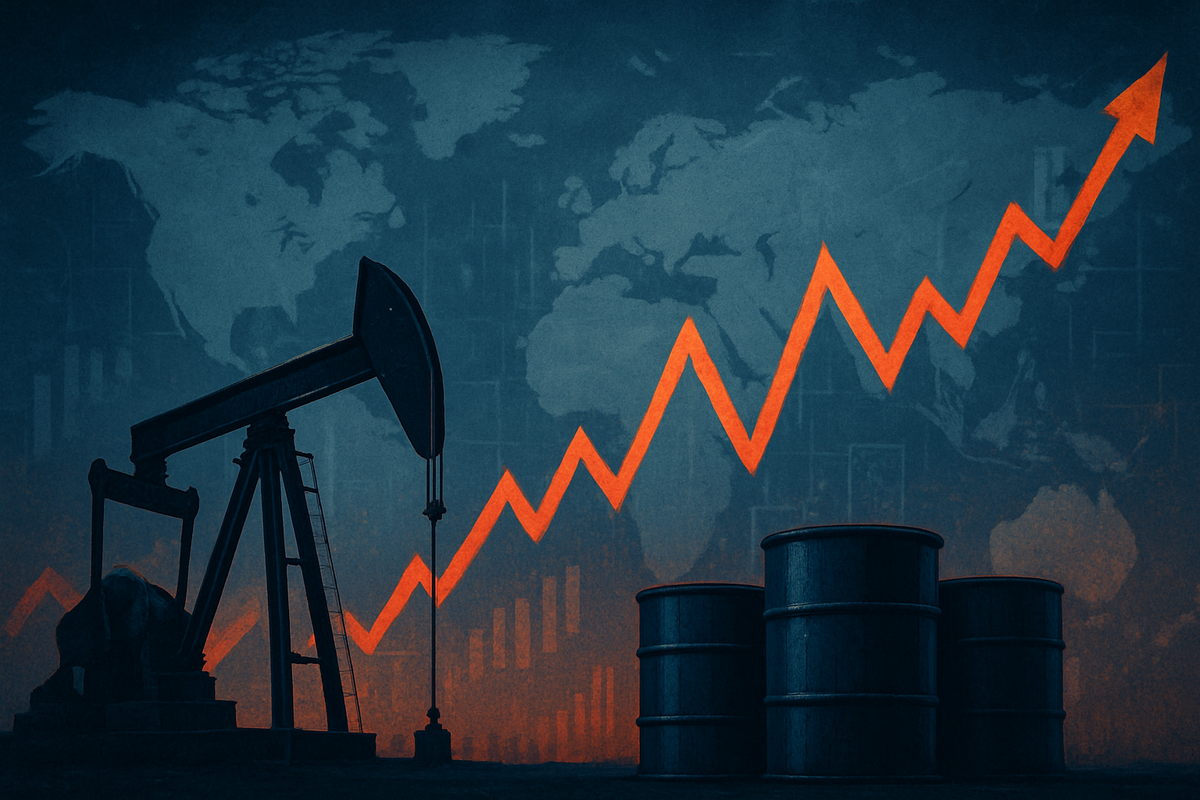
The global oil market has been a theatre of dramatic shifts throughout 2025, witnessing significant price surges in the earlier part of the year driven by a potent mix of geopolitical tensions, strategic production cuts, and robust demand expectations. While the market currently finds itself navigating a period of moderation and even decline as of November 7, 2025, the reverberations of these earlier price spikes continue to shape the strategies and fortunes of public companies within the energy sector, highlighting the inherent volatility and complex interplay of forces at play.
These "recent surges" (referring to late 2024 and early to mid-2025) presented a challenging yet opportunistic landscape, fueling inflationary pressures globally and significantly impacting operating costs across various industries. For energy companies, the period of elevated prices offered a temporary boon, bolstering revenues and prompting shifts in investment strategies, even as the subsequent market correction demands swift adaptation and renewed focus on efficiency.
A Turbulent Timeline: Geopolitics, Production Cuts, and Demand Drive 2025's Oil Price Spikes
The journey to the current market state on November 7, 2025, was paved with several distinct periods of upward price momentum. Late 2024 saw initial fluctuations, with WTI and Brent crude experiencing temporary support from various factors like hurricane impacts and OPEC+ decisions, only to be tempered by inventory concerns. However, the true "surge" narrative began to unfold more prominently in early 2025.
January 2025 witnessed a significant rally, with oil prices climbing by an average of 10%. US crude (WTI) breached $79 per barrel, and Brent crude surpassed $81, marking five-month highs. This ascent was primarily attributed to renewed US sanctions on Russia's energy sector, sparking fears of reduced supply. Concurrently, strong US economic growth and Chinese stimulus measures fueled expectations of increased global demand. The OPEC+ alliance further solidified this upward trend by extending production restrictions, deliberately tightening market liquidity.
Another notable surge occurred in April 2025, pushing crude prices past $64.50 per barrel, representing a 16% weekly increase. This spike was largely a consequence of escalating tensions in the Middle East, including drone strikes on Saudi Arabian oil infrastructure and renewed sanctions on Iranian exports, which collectively disrupted an estimated 500,000 barrels per day (bpd) of global supply. OPEC+ extended its substantial 2.2 million bpd production cuts, and Russia pledged its own 500,000 bpd reduction, creating a significant supply deficit. Mid-2025 even saw projections from analysts, including JPMorgan, warning of Brent potentially reaching $120 per barrel if conflicts in the Middle East, particularly concerning the Strait of Hormuz, escalated further. Initial market reactions to these surges were swift and widespread, manifesting as heightened inflationary pressures, increased operational costs for oil-dependent industries like transportation and manufacturing, and a general sense of economic uncertainty, prompting investors to seek safe-haven assets.
Winners and Losers: The Shifting Fortunes of Energy Sector Giants
The volatile landscape of surging oil prices in early to mid-2025 created a clear delineation between potential winners and those facing significant challenges within the energy sector.
Upstream oil and gas producers were the primary beneficiaries. Companies heavily invested in exploration and production (E&P) saw their revenues swell as the price per barrel increased. Integrated energy majors with substantial upstream assets, such as ExxonMobil (NYSE: XOM) and Chevron (NYSE: CVX), reported improved earnings and cash flows. These companies often leveraged the higher prices to boost capital expenditure in new drilling projects, pay down debt, or return value to shareholders through dividends and share buybacks. Smaller, independent E&P firms, particularly those with efficient operations in key shale plays, also experienced a significant uplift, finding renewed viability for projects that were marginal at lower price points.
Conversely, downstream refiners initially faced a complex situation. While lower crude prices (as seen in the current decline) generally benefit them, during the surge, if the cost of crude feedstock rose faster than the prices of refined products like gasoline and diesel, their margins could be squeezed. However, robust demand for refined products often allowed them to pass on some of the increased costs. Transportation companies, including airlines like Delta Air Lines (NYSE: DAL) and major trucking firms, faced significant headwinds as jet fuel and diesel costs soared, directly impacting their profitability and potentially leading to higher fares and freight charges for consumers. Chemical companies, which use petroleum derivatives as primary feedstocks, also grappled with increased input costs. Companies with less diversified portfolios or higher operating costs were particularly vulnerable to the rapid shifts, struggling to adapt their cost structures quickly enough to maintain profitability as the market transitioned from surge to decline.
Broader Implications: Reshaping Industries and Policies
The oil price surges of early to mid-2025 had far-reaching implications beyond immediate corporate balance sheets, influencing broader industry trends, regulatory landscapes, and global economic stability.
One significant effect was the acceleration of the energy transition. Sustained periods of high oil prices made alternative energy sources, such as solar, wind, and electric vehicles, more economically competitive and attractive. This spurred increased investment in renewable energy projects and intensified research and development into green technologies, as both governments and corporations sought to reduce reliance on volatile fossil fuel markets. The ripple effects were felt across various sectors; for instance, the automotive industry saw renewed impetus to push EV adoption, while utility companies explored expanding their renewable generation capacities.
Economically, the surges contributed to global inflationary pressures, forcing central banks worldwide to grapple with the dilemma of controlling rising prices without stifling economic growth. Higher oil prices translated directly into increased gasoline prices for consumers, eroding purchasing power and impacting consumer confidence. Governments faced calls to intervene, with discussions around releasing strategic petroleum reserves and revisiting energy independence policies gaining traction. Historically, such oil shocks have often preceded economic slowdowns, and the 2025 surges served as a stark reminder of oil's pivotal role in global economic health, drawing comparisons to past energy crises where geopolitical instability and supply constraints fundamentally reshaped international relations and economic policies.
What Comes Next: Navigating a Volatile Future
As of November 7, 2025, the oil market presents a nuanced picture, having shifted from the earlier surges to a period of decline driven by concerns of oversupply and weakening demand. This current reality shapes the short-term and long-term outlook for the energy sector.
In the short term, continued volatility is expected. While current prices are trending downwards, geopolitical flashpoints, OPEC+ production decisions, and unexpected demand shifts could trigger sudden spikes. Companies will need to prioritize agility and cost efficiency to weather these fluctuations. The current lower crude prices could benefit refiners and consumers, offering a reprieve from the inflationary pressures of earlier in the year. However, upstream producers will face renewed pressure on revenues and profitability, potentially leading to reduced capital expenditure and a focus on maintaining existing production rather than expanding.
Looking long term, the industry faces strategic pivots. Energy companies are increasingly diversifying their portfolios, investing in renewable energy and low-carbon solutions to hedge against fossil fuel price volatility and align with global sustainability goals. Consolidation within the traditional oil and gas sector might accelerate as smaller, less efficient players struggle in a lower-price environment. Market opportunities may emerge in areas like carbon capture technologies, hydrogen production, and advanced biofuels. Conversely, challenges include stringent environmental regulations, increasing investor pressure for ESG (Environmental, Social, and Governance) compliance, and the ongoing global push for decarbonization. Potential scenarios range from a sustained period of lower prices due to robust supply and slowing demand, punctuated by short, sharp rallies driven by unforeseen geopolitical events, to a more balanced market if OPEC+ can effectively manage supply.
Wrap-up: A Market in Flux
The oil market's journey through 2025, from significant price surges in its earlier months to the current decline as of November 7, underscores the dynamic and often unpredictable nature of global energy dynamics. The earlier surges, fueled by geopolitical tensions, strategic supply management by OPEC+, and robust demand expectations, served as a powerful reminder of oil's critical role in the global economy and its immediate impact on inflation and industrial costs.
Moving forward, the market is characterized by a complex interplay of forces. While current oversupply concerns and weakening global demand point towards a bearish outlook for crude prices, the ever-present specter of geopolitical instability and the strategic decisions of major producers mean that the potential for future price spikes remains. Investors should closely monitor several key indicators: OPEC+ production quotas and compliance, global economic growth forecasts (particularly from major consumers like China and the US), crude oil inventory levels, and any escalation of geopolitical tensions in key oil-producing regions. The lasting impact of the earlier surges includes an accelerated push towards energy transition and a heightened awareness of supply chain vulnerabilities, shaping strategic decisions across the energy sector for years to come.
This content is intended for informational purposes only and is not financial advice





